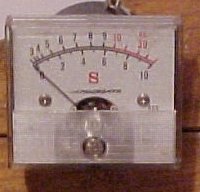


An S-meter is simply a sensitive movement which measure current through an agc line to give a relative indication of signal strength. The face of an S-meter is calibrated in units S1 to S9 plus levels of dB over S9. There is no real official standard for S-meters as such.
I assume you understand both I.F. amplifiers and automatic gain control (A.G.C.). The agc works to maintain a relatively constant audio output consistent with the setting of your volume control. It works on the principle if there is a strong signal at the final detector of the receiver then a counter dc signal goes back to the if amplifiers to reduce the gain to a pre-set level.
Alternatively with weak signals, this dc signal is almost absent allowing the if amplifier to go full gain. For received signals which are somewhere in between weak and strong the dc signal is proportional.
Ideally, under any received signal conditions the signal level at the detector should be a constant 1V p/p, all controlled by the agc.
An S-meter is simply a meter set up to measure the current through the agc control line so that on strong signals it shows say S9 + 20 dB while on weak signals it might be at the bottom end of the scale on say S1 or S2.

Figure 1 - an S meter
Be aware, they are notoriously inaccurate, can not be compared between various receivers and are only useful for relative measurements applicable to your receiver, using your current antenna, at your present location and on one particular band.
They are widely misunderstood and all too often an S meter is given a level of importance they don't rightly deserve.
S-meters are as accurate as a group of people standing by the road and individually estimating the speed of passing vehicles.
1. radio terminology A - L